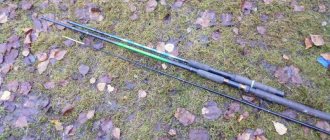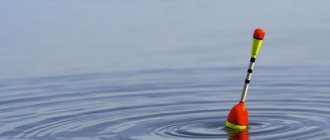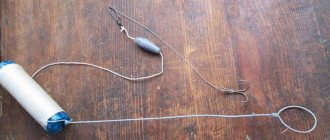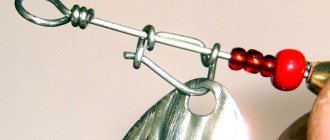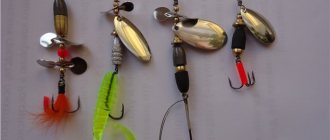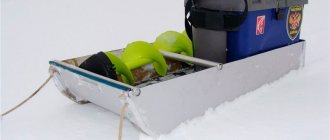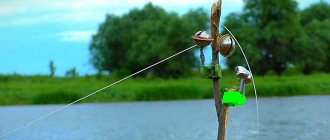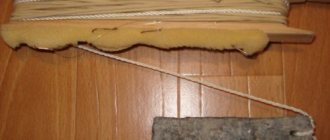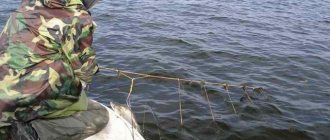Despite the fact that the modern gear market is distinguished by a large abundance of various devices designed for fishing, many outdoor enthusiasts prefer to use the “old-fashioned” methods of catching underwater inhabitants. One of these methods is fishing with a line, which does not require much effort from a person. Perhaps this is why such fishing is strictly prohibited on the territory of the Russian Federation. Therefore, our article is for informational purposes only. We do not encourage readers to break the law.
What is a shift?
Fishing with a line is well known to our grandfathers and great-grandfathers, when instead of sophisticated spinning rods they had to use ordinary bamboo fishing rods equipped with a goose feather instead of a float. However, with the help of such gear it was hardly possible to catch many large fish. That is why the so-called net was invented - a net with numerous hooks, which can have a different design depending on the type of fish that you plan to catch.
Typically, amateur gear contains no more than 10 hooks with bait, since a large net on the river will immediately attract attention. Typically, nets are placed near the shore and reeds where large fish spawn. Also, every fisherman should understand that if he installs too many hooks, he risks not only incurring problems with the law, but also significantly reducing the amount of fish resources in the river.
Float fishing techniques
This tackle was appreciated by our grandfathers for its simplicity of design.
The net is based on a long cord or thick fishing line. Its ends were usually tied to stakes driven into the bottom. Leashes with hooks were attached to the base. Their quantity is limited to 5-10 pieces.
A loop system was used to connect the leads to the main line. This has its advantages. Thanks to this installation, it was possible to store leashes with hooks separately from the saddle. Today, you can attach them to the cord using swivels and carabiners.
To avoid overlapping of leashes, it is necessary to strictly maintain the distance between them. Calculating the optimal length is easy. The size should be 1-2 cm less than half the length between adjacent leashes.
If the hooks are not removed from the tackle during transportation, then the tip of each of them is hidden in pieces of cork. Some experienced anglers make a reel out of foam. In this case, you can wind the hooked webbing and hide the sting in foam plastic.
Nowadays, there are many methods of fishing, as well as a huge number of different types of devices designed for this. Gear differs in its operating principle, can produce different volumes of production, require different amounts of attention and arouse more or less interest from the fisherman.
They also differ depending on the goal that the fisherman sets for himself. Some devices are used primarily for relaxation and a pleasant pastime, and some are used to obtain a large amount of catch.
The latter includes a tackle known to many - a seine. It is one of those devices that help catch large specimens of various types of fish in large volumes, requiring minimal human intervention and attention.
The main thing is to figure out how to make a crossing and install it in a pond.
Why is it undesirable to catch a line?
The line belongs to the category of prohibited gear, unless, of course, we are talking about commercial fishing. As for ordinary fishing enthusiasts, if you come to the attention of special authorities, you can become liable before the law.
For crucian carp fishing, fly and match gear are used.
The fly rod allows you to catch fish at a distance of up to 15 meters and control the process using a float. A 0.2 mm fishing line with equipment is attached to the end of the rod.
The installation of rubber shock absorbers is acceptable here and will soften the jerks of large fish, preventing the leader from breaking. The length of all equipment must match the length of the fishing rod.
You can fish from the shore, bridges, boats and other watercraft.
The match fishing rod is equipped with a reel, which allows you to cast the bait over longer distances and use thinner lines, because A properly adjusted drag on the reel prevents line breakage and neutralizes the jerks of large fish.
Catching crucian carp with a fishing rod requires precise loading of the float: the working part of the signal antenna remains above the surface of the water, colored more brightly.
Floats are marked with two numbers: the designation of its weight and the weight of the sinker that supports the float in the working position. Additionally, float products are equipped with collapsible keels having a different number of washers. With their help, it is convenient to control the weight of the float and change the speed of lowering the baits to the bottom.
The best fishing rod length is 5-6 m, the material is strong and rigid, capable of withstanding the “tearing out” of large fish from tangled aquatic vegetation. The length of the fishing rod should allow the tackle to be cast far, and the fisherman to sit on the shore and not in the swamp.
Saddle design
To organize catch fishing on the river, you need to make gear, the number of hooks in which will not exceed 10 pieces. In addition, the design must contain the following elements:
- a long rope, cord or cable for pulling out the saddle;
- several leashes made of strong thread, which are necessary for attaching hooks;
- at least four wooden stakes, which are needed to secure the line near the shore.
The leads must be attached at the same distance, otherwise the design will not work properly. You can choose any fastening method, but the preferred option is a loop connection with carabiners.
As for the stakes, they must be sharp and long enough to stick into the ground. For fishing in bodies of water with strong currents, it is advisable to use metal elements, since they hold the line more reliably.
When, where and how to catch?
You can catch catfish using a line at any time of the year. But in winter only when the reservoir is not covered with ice. After all, the presence of such an obstacle makes fishing with a line impossible.
There is no specific fishing spot for catfish; any hole, spit or riffle is suitable. After all, catfish can swim anywhere, as they swim out at night in search of food.
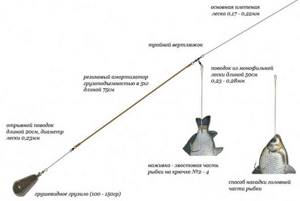
You can set a line both in rivers and on lakes. For each type of reservoir there is a different installation method. For rivers you need to place it in the middle of the current, and in closed reservoirs - not far from the shore, where the fish are often fed.
You need to carefully choose the installation location, because if there are snags at the bottom, the net may get caught, and this will lead to loss of gear.
For bait, you can use live bait, such as crucian carp, burbot, bindweed or other types of fish that have high endurance. You can also use chicken or fish offal. A fish like catfish will not refuse frogs (especially river ones), crayfish or red worms.
Catfish are often caught using leeches or mole crickets, because they stay on the hook for a very long time.
Predatory fish like pike perch, catfish and pike hunt around the clock. However, on hot days their activity decreases noticeably. It is advisable to load the net with fresh live bait at night, and check and change the bait early in the morning. If the place and depth of immersion for the hooks are chosen correctly, then the catch can turn out to be solid, and the fish soup fatty and rich.
Predatory fish hunt all year round, which means catch fishing knows no restrictions. The exception is spring, when fishing is prohibited by law, and hot summer days, when all the fish lose activity.
Night is the best time to move. Pike, perch and catfish scour the bottom in search of prey, which means the tackle can be rechecked every two to three hours. At dawn, the line is loaded with fresh bait and left until the evening.
Types of saddles
Have you decided to make a line for fishing? Then first you will need to decide on the type of tackle that you plan to make. Professional fishermen identify the following fishing nets for river fishing, which you can easily make with your own hands:
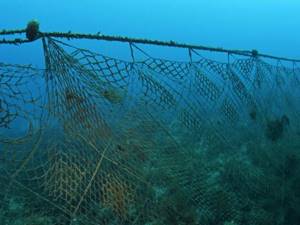
- riding - an ideal specimen for fish that prefer to live on the surface (trout, asp, chub and small individuals of almost all species);
- medium - used for fishing under water (the trophies include pike, sabrefish, rudd, perch, and so on);
- bottom - installed in the lower layers of the reservoir and is used to catch the largest individuals of deep-sea fish (carp, catfish, burbot).
So before you make a catch, be sure to decide on the type of fish you plan to catch. Otherwise, you will make bottom tackle that is suitable for catching species that simply are not in the reservoir.
Installation nuances
To catch fish on the river using a line, you must follow certain installation rules, without which it is unlikely that you will be able to achieve a large catch. In total, professionals identify three basic rules that are most often ignored by novice fishermen:
- When fishing with riding gear, it is necessary to attach the line to a wooden peg not far from the shore. Even if the freshwater body does not have a strong current, the nets can move to the side due to the resistance of the fish, making them difficult to find.
- Also, several weights must be installed on the fishing line or ropes with hooks, which will hold the bait in a static position. Otherwise, the underwater current will overturn the hook over the net and the entire tackle will become tangled, and the fish will never find the bait.
- The middle lines are installed in the same way as the top ones, however, there should be floats in the cords between the leashes, which will signal whether the fish is hooked or not. The fishing depth is adjusted using weights, which are resisted by floats.
It is also strongly recommended to install gear only in places where there are no prying eyes. Otherwise, one of the fishermen will want to steal or spoil the line. It would be best to set the nets in the evening in order to check the catch in the morning.
Bottom gear
Most often, when catching carp, bottom tackle is used. There can be many varieties of it. This can be a classic carp tackle with main, spod and marker rods. There are quite a lot of them, and a carp angler’s arsenal can be compared to a golfer’s arsenal of clubs, of which there are more than a dozen in the case and each of them is needed for a specific situation.
This could be a feeder, which is also used when fishing for carp. Usually, a carp hair mount is installed on the feeder. The difference between feeder fishing and carp fishing here will be in the bite signaling. Carp rigs in English or homemade form offer a good chance of self-hatching fish; when fishing on a feeder with it, you don’t have to look too much at the quivertip. And if traditional equipment is used, when an animal bait is placed on a hook, then the fisherman’s qualifications are already required in determining the moment of hooking. You can successfully catch carp with a feeder in the autumn, before setting up for the winter.
Zakidushka is practiced by most fishermen living near the habitats of carp. These can be both urban and rural fishermen, for whom fishing is not only pleasure, but also a delicious dinner. The tackle is used only with a sliding sinker, below which the homemade carp equipment described above is placed. The zakidushka is placed near the habitats of the carp. These are thickets of aquatic plants at a sufficient depth. Since fishing in the thickets themselves with donka is problematic, anglers are forced to look for gaps among them, or clear them themselves.
Finally, the aforementioned change. Used on rivers, you can place it with an anchor on a lake or pond, or you can place it across the river. At the same time, it is necessary to observe the limit on the number of hooks for one angler and fish only during the permitted period. A boat is required to set up the crossing.
One of the most important accessories for bottom fishing is a bite alarm. Traditionally, carp fishing uses a swinger, bell or electronic alarm. A carp fisherman places several fishing rods along the shore, which can be located quite far away. Instant hooking on a carp mount is not always necessary. But you need to quickly determine which fishing rod the fish bit on. Therefore, they install sound alarms and reels with baitrunners so that the carp does not steal the tackle. Of course, a traditional quivertip signaling device is used for the feeder.
Varieties of lures and lures
It is not difficult to guess that to catch fish on the river, you will have to use a variety of baits and lures. The choice directly depends on the type of freshwater inhabitant that the fisherman plans to catch. Here is a small instruction that will help novice fishermen:

- It is best to catch predatory fish using live bait or emitting bait;
- It is best to hook the fry by the upper lip so that they hold on tighter;
- Dead baitfish are an ideal solution for areas with snags.
As for peaceful fish, to catch it you will need to use the most common bait, which can be found in every home. For example, rudd, roach and crucian carp bite quite well on pearl barley, dough, peas and corn. And most predators will not refuse to feast on dung worms.
Peculiarities of fish biting
To effectively catch a spotted predator, you need to know how and when burbot activity manifests itself. The pre-spawning fish feast begins in the fall and lasts for several months. At this time, burbot is extremely active, moving around the water area of the reservoir hunting for small things. As a rule, this period lasts until January.
After feeding, the fish goes to spawn and reacts very sluggishly to the offered bait. But this does not mean that it is not worth hunting for burbot at this time - with proper preparation, the catch is guaranteed.
Read: Winter fishing. Drilling holes
Spawning has passed, the spotted one gradually awakens and again begins to absorb various baits. This stage will last until May, until the predator goes into suspended animation.
Burbot is a nocturnal fish and goes out hunting in the dark, so fishing during daylight hours does not give results. It’s better to prepare well in the light, place bait and wait for the night bite.
Making catfish litter
To make it easier for novice fishermen to make gear at home, we have compiled special instructions that will help realize the idea. To catch catfish using a net, you will need to use the following elements:
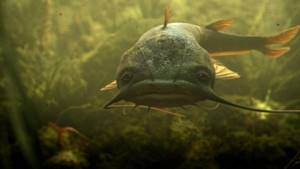
- fishing line with a section thickness from 0.7 to 0.8 millimeters;
- several hooks of the tenth or fifteenth number;
- sinker, the total weight of which is 250 grams;
- nylon cord from 15 to 25 meters.
If you plan to catch a large catfish, then the number of hooks should be reduced to 2-3, since too many individuals can simply tear the stakes holding the line out of the ground. You should also increase the number of hooks to seventeen.
Features of catching burbot using a line
In winter, many fishermen head to frozen bodies of water to catch a few large burbot. Typically, for this event, a bottom type of gear is used, which is immersed in the water using a heavy weight. The length of the line should be from 15 to 25 meters, and the optimal number of hooks should be from 5 to 7 (depending on the size of the individual).
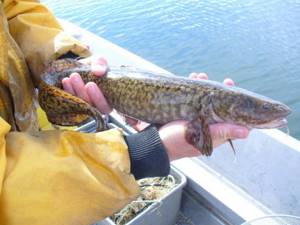
As for bait, the best option is fresh live bait attached to a number 12 rig. Although in the winter season the individual will not disdain ordinary dung worms. But it is best to refrain from using any imitation baits. The bait is in a static position under water, and the burbot is interested in the bait moving or smelling.
Where to find winter burbot
They say that if you find a burbot trail, a good catch is guaranteed. Finding it is not easy, but the more pleasant the result. Remember this place so that you can return there year after year, until the bottom topography changes radically and the fish stop biting there.
The easiest and fastest way to search is to find and ask an experienced harbour fisherman. But will he want to give you his “secret” place? However, a real trophy hunter is much more interested in putting his experience into practice and discovering the trail on his own.
The most important rule: burbot does not tolerate dirt, so immediately sweep away sources with muddy bottoms and standing water. But fish live happily in clean, running water. Inspect areas with sandy, pebble soil, and bottom debris. Predators also like snags in reservoirs near exits to shallow waters and spits.
Read: Fishing for trout in winter
How to catch a large sterlet?
Have you decided to organize sterlet fishing? As a rule, this type of fish lives at shallow depths, so to catch it you will have to use top or medium rigs. In most cases, crossings are installed in the winter season. To do this, several holes are drilled in the ice, after which nets with small weights are immersed in the water. To prevent the current from catching the line, it is tied well to the pegs.
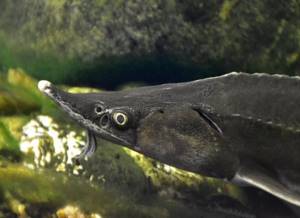
As for bait, sterlet is considered one of those types of fish that is extremely unpretentious in food. In winter, it is best to use an earthworm or dungworm, maggot or bloodworm larva. Peas and corn will perform slightly worse. Well, in order to lure fish from a long distance, you should use a pre-prepared bait from makukha.
Pike fishing in winter
Why is catching in winter so popular? The thing is that this equipment shows its greatest effectiveness when using live bait as bait. Who is the best at catching small fish? That's right, predators that are most active in autumn and winter, while other types of fish are not fast.
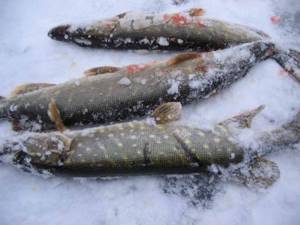
To catch several large pikes, you need to attach 7 to 8 number 10 hooks to the line. If you plan to use imitation bait, then its quantity should directly depend on the size. After all, the larger the spinner, the stronger the individual that will fall for it. You can also simply bait a few worms on a hook, but in this case, perch may also be caught.
To lure large pike, most amateur fishermen use various pheromone-based baits. However, professionals in their field know that there is nothing better than a bite activator - a special electronic device that allows you to lure large individuals from all over the area. Something like decoys that hunters use.
Shall we catch pike perch on the line?
It is most promising to carry out this event in the autumn season, when the fish stores fat for the winter and increases in size. As gear, of course, you will have to install a bottom crossbar. It is best to do this in a narrow river bed, since this is where the pike perch are most often found. In summer, they practice installing bottom gear in the shallows, since in hot weather the predator goes hunting for small fish.
It is best to install gear in the evening, since pike perch are most active at night. Any small fish (bleak, roach, rudd) is suitable as bait. When installing the fence, be sure to take into account the nature of the current so that the pike perch does not pull out the stakes. In addition, size thirteen hooks should be used so that the catch cannot escape from the fisherman.
To increase the likelihood of catching walleye, many professional fishermen use echo sounders to scan the bottom topography. Such devices make it possible without any problems to determine exactly where underwater there are large holes in which pike perch prefer to live. You can also use additional bait with pheromones, which will lure underwater inhabitants from all over the area.
